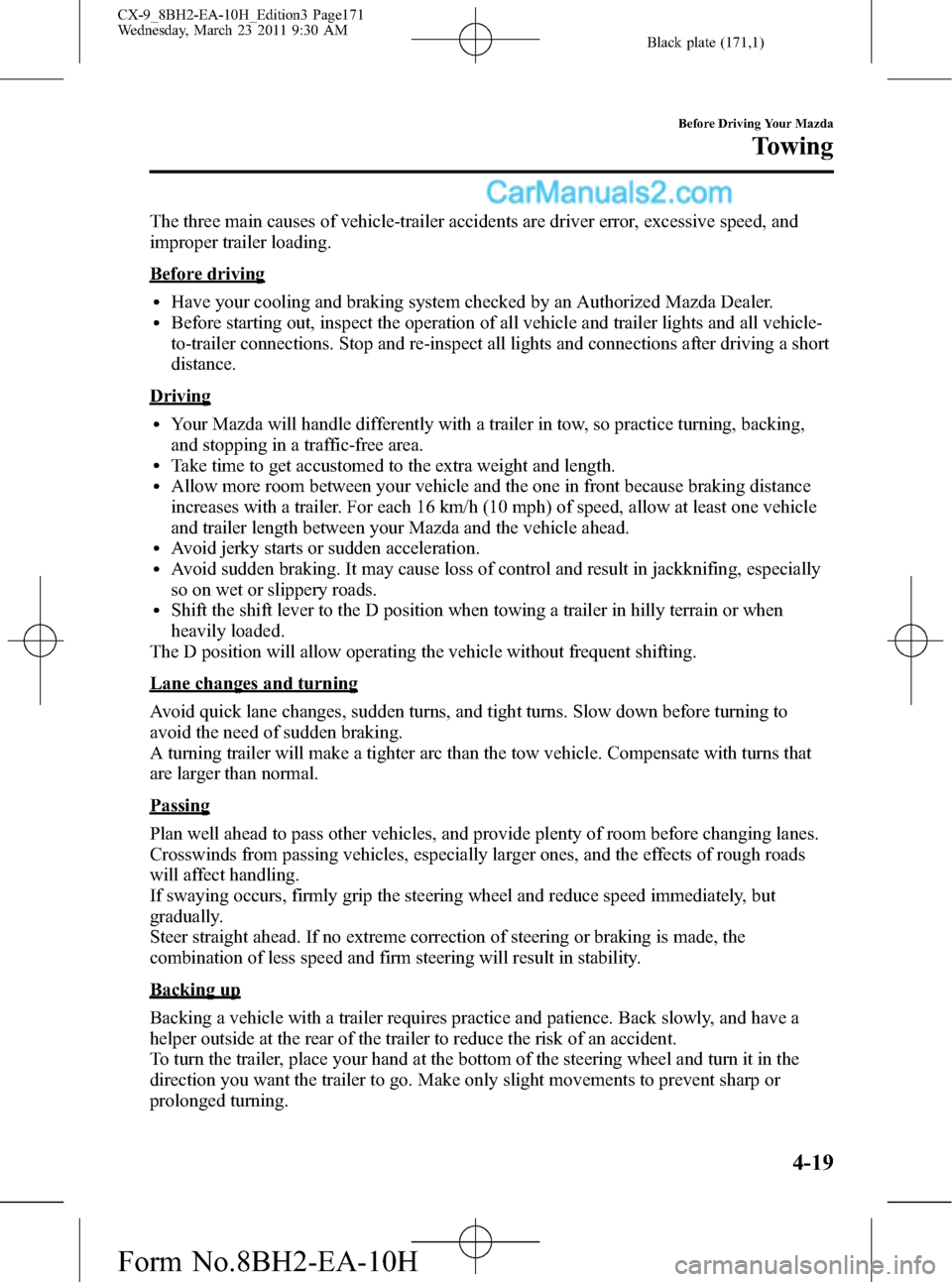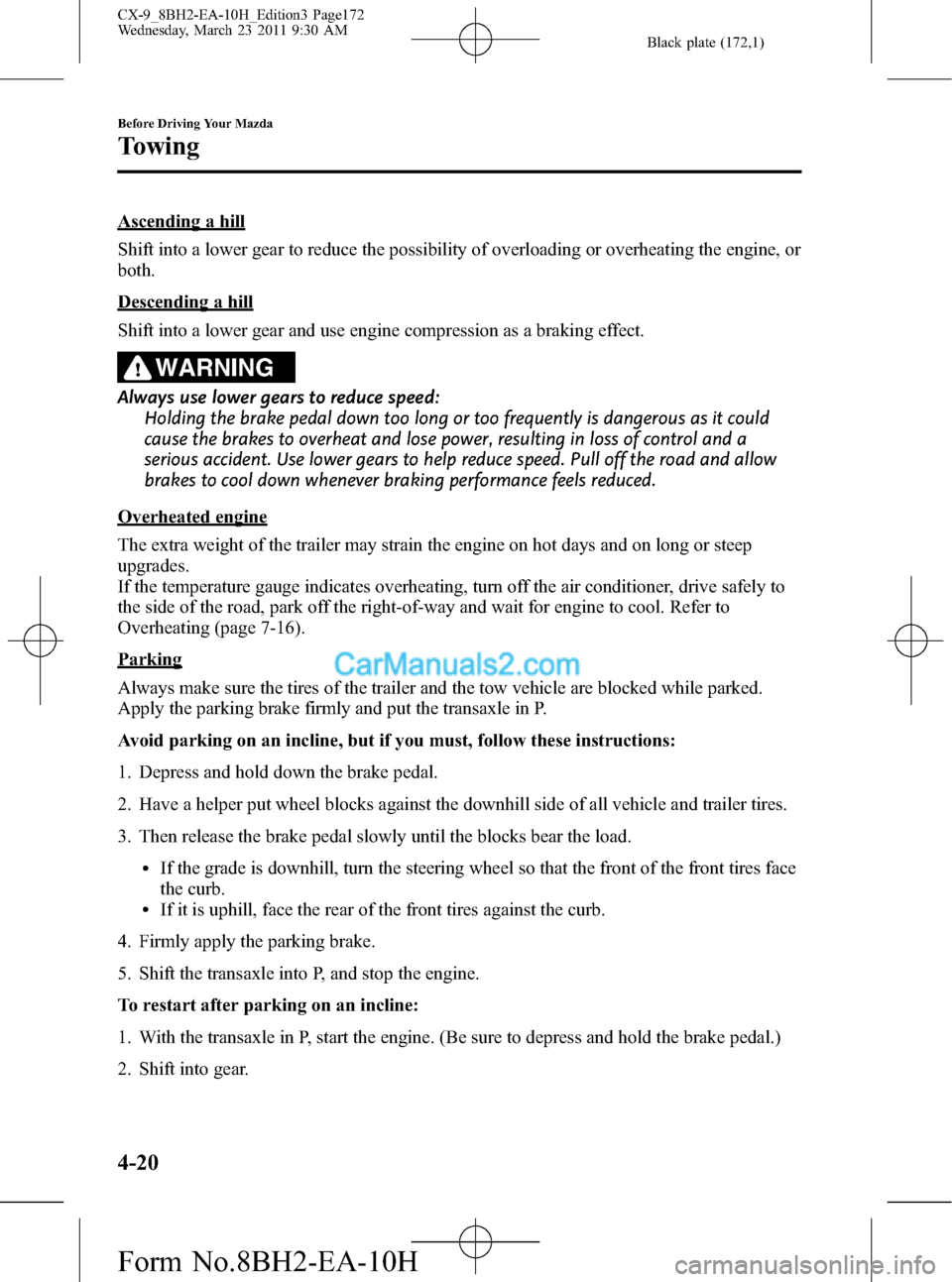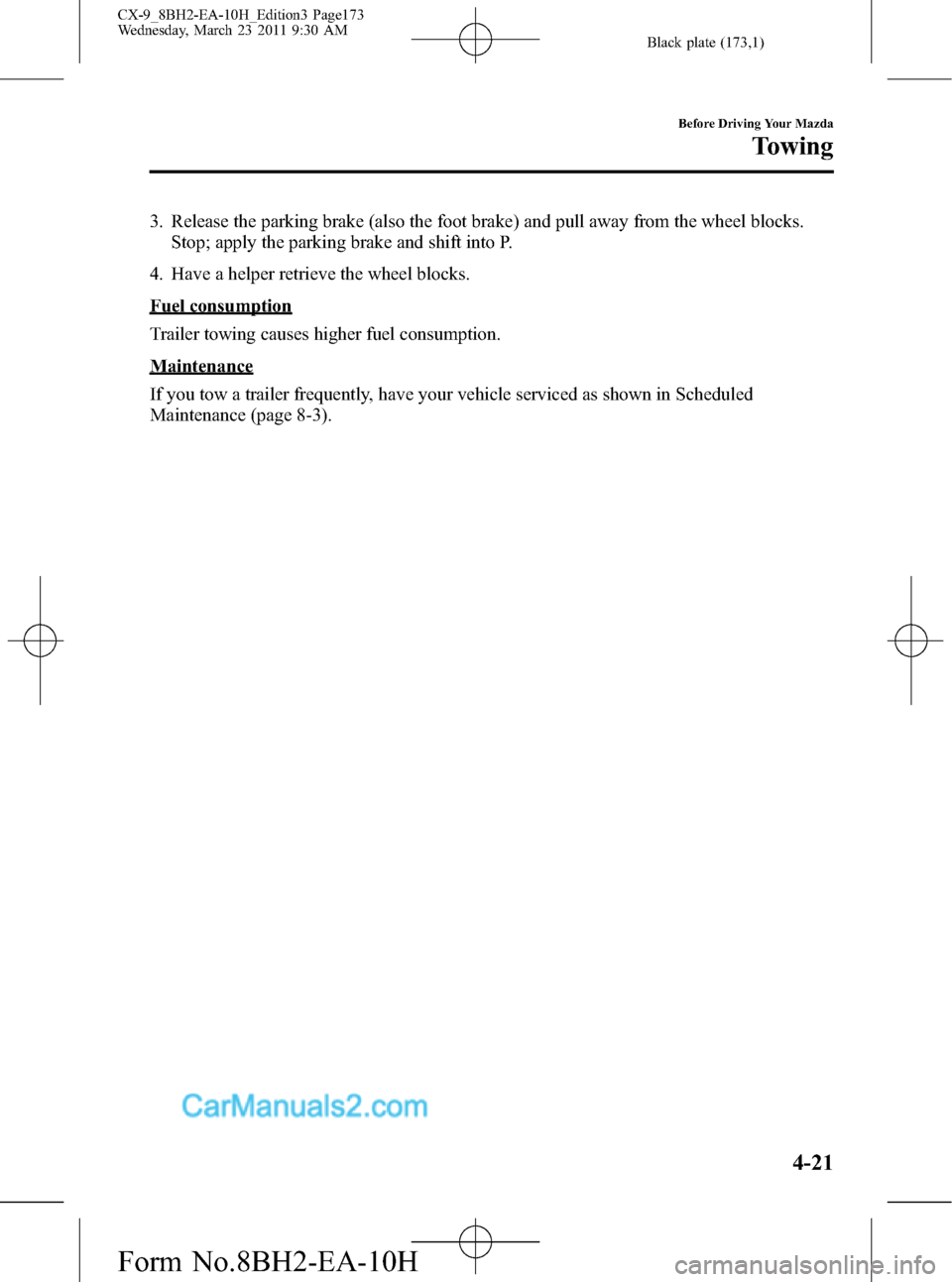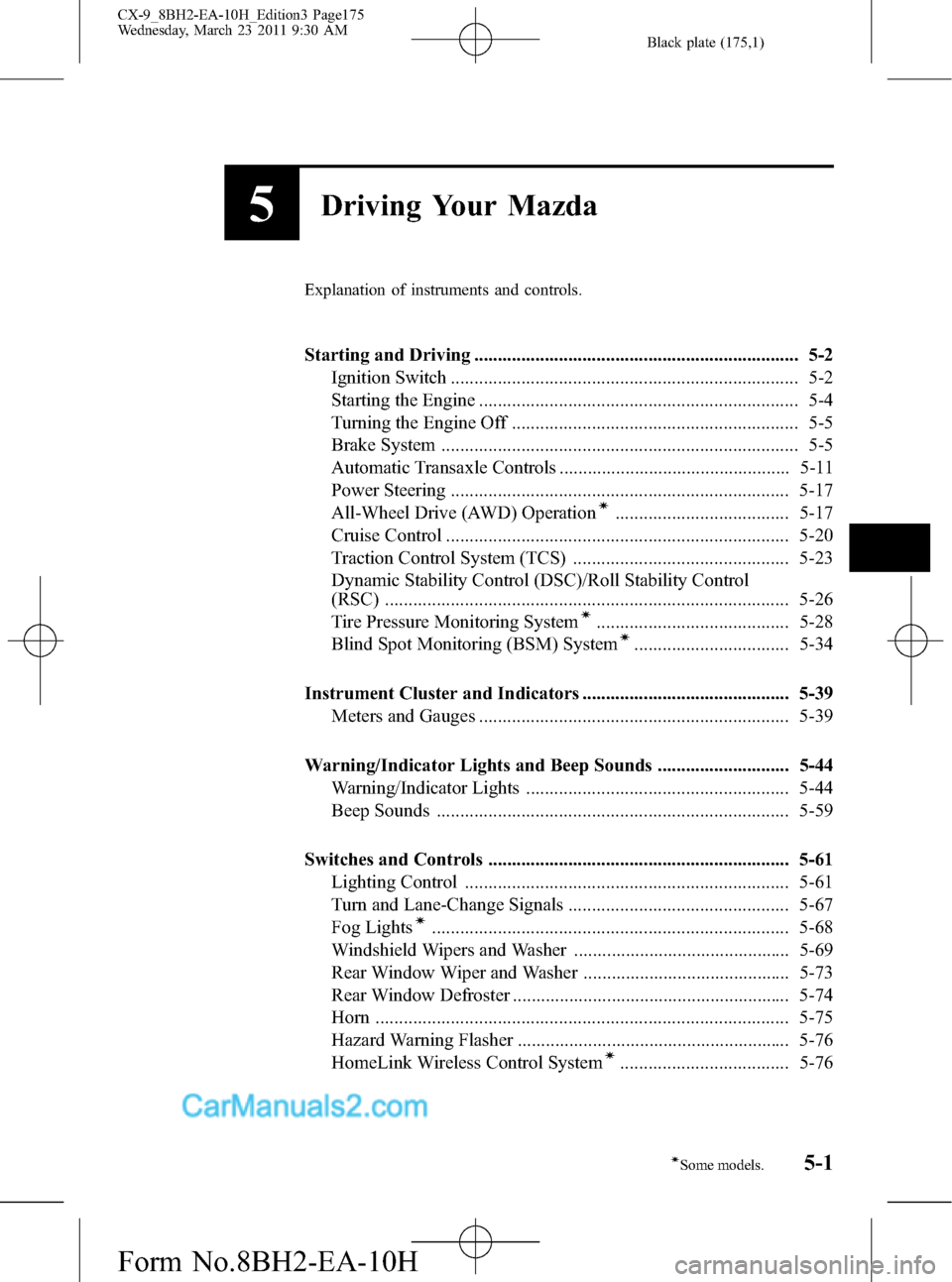MAZDA MODEL CX-9 2011 Owners Manual (in English)
Manufacturer: MAZDA, Model Year: 2011, Model line: MODEL CX-9, Model: MAZDA MODEL CX-9 2011Pages: 606, PDF Size: 13.55 MB
Page 171 of 606

Black plate (171,1)
The three main causes of vehicle-trailer accidents are driver error, excessive speed, and
improper trailer loading.
Before driving
lHave your cooling and braking system checked by an Authorized Mazda Dealer.lBefore starting out, inspect the operation of all vehicle and trailer lights and all vehicle-
to-trailer connections. Stop and re-inspect all lights and connections after driving a short
distance.
Driving
lYour Mazda will handle differently with a trailer in tow, so practice turning, backing,
and stopping in a traffic-free area.
lTake time to get accustomed to the extra weight and length.lAllow more room between your vehicle and the one in front because braking distance
increases with a trailer. For each 16 km/h (10 mph) of speed, allow at least one vehicle
and trailer length between your Mazda and the vehicle ahead.
lAvoid jerky starts or sudden acceleration.lAvoid sudden braking. It may cause loss of control and result in jackknifing, especially
so on wet or slippery roads.
lShift the shift lever to the D position when towing a trailer in hilly terrain or when
heavily loaded.
The D position will allow operating the vehicle without frequent shifting.
Lane changes and turning
Avoid quick lane changes, sudden turns, and tight turns. Slow down before turning to
avoid the need of sudden braking.
A turning trailer will make a tighter arc than the tow vehicle. Compensate with turns that
are larger than normal.
Passing
Plan well ahead to pass other vehicles, and provide plenty of room before changing lanes.
Crosswinds from passing vehicles, especially larger ones, and the effects of rough roads
will affect handling.
If swaying occurs, firmly grip the steering wheel and reduce speed immediately, but
gradually.
Steer straight ahead. If no extreme correction of steering or braking is made, the
combination of less speed and firm steering will result in stability.
Backing up
Backing a vehicle with a trailer requires practice and patience. Back slowly, and have a
helper outside at the rear of the trailer to reduce the risk of an accident.
To turn the trailer, place your hand at the bottom of the steering wheel and turn it in the
direction you want the trailer to go. Make only slight movements to prevent sharp or
prolonged turning.
Before Driving Your Mazda
Towing
4-19
CX-9_8BH2-EA-10H_Edition3 Page171
Wednesday, March 23 2011 9:30 AM
Form No.8BH2-EA-10H
Page 172 of 606

Black plate (172,1)
Ascending a hill
Shift into a lower gear to reduce the possibility of overloading or overheating the engine, or
both.
Descending a hill
Shift into a lower gear and use engine compression as a braking effect.
WARNING
Always use lower gears to reduce speed:
Holding the brake pedal down too long or too frequently is dangerous as it could
cause the brakes to overheat and lose power, resulting in loss of control and a
serious accident. Use lower gears to help reduce speed. Pull off the road and allow
brakes to cool down whenever braking performance feels reduced.
Overheated engine
The extra weight of the trailer may strain the engine on hot days and on long or steep
upgrades.
If the temperature gauge indicates overheating, turn off the air conditioner, drive safely to
the side of the road, park off the right-of-way and wait for engine to cool. Refer to
Overheating (page 7-16).
Parking
Always make sure the tires of the trailer and the tow vehicle are blocked while parked.
Apply the parking brake firmly and put the transaxle in P.
Avoid parking on an incline, but if you must, follow these instructions:
1. Depress and hold down the brake pedal.
2. Have a helper put wheel blocks against the downhill side of all vehicle and trailer tires.
3. Then release the brake pedal slowly until the blocks bear the load.
lIf the grade is downhill, turn the steering wheel so that the front of the front tires face
the curb.
lIf it is uphill, face the rear of the front tires against the curb.
4. Firmly apply the parking brake.
5. Shift the transaxle into P, and stop the engine.
To restart after parking on an incline:
1. With the transaxle in P, start the engine. (Be sure to depress and hold the brake pedal.)
2. Shift into gear.
4-20
Before Driving Your Mazda
Towing
CX-9_8BH2-EA-10H_Edition3 Page172
Wednesday, March 23 2011 9:30 AM
Form No.8BH2-EA-10H
Page 173 of 606

Black plate (173,1)
3. Release the parking brake (also the foot brake) and pull away from the wheel blocks.
Stop; apply the parking brake and shift into P.
4. Have a helper retrieve the wheel blocks.
Fuel consumption
Trailer towing causes higher fuel consumption.
Maintenance
If you tow a trailer frequently, have your vehicle serviced as shown in Scheduled
Maintenance (page 8-3).
Before Driving Your Mazda
Towing
4-21
CX-9_8BH2-EA-10H_Edition3 Page173
Wednesday, March 23 2011 9:30 AM
Form No.8BH2-EA-10H
Page 174 of 606

Black plate (174,1)
4-22
CX-9_8BH2-EA-10H_Edition3 Page174
Wednesday, March 23 2011 9:30 AM
Form No.8BH2-EA-10H
Page 175 of 606

Black plate (175,1)
5Driving Your Mazda
Explanation of instruments and controls.
Starting and Driving ..................................................................... 5-2
Ignition Switch .......................................................................... 5-2
Starting the Engine .................................................................... 5-4
Turning the Engine Off ............................................................. 5-5
Brake System ............................................................................ 5-5
Automatic Transaxle Controls ................................................. 5-11
Power Steering ........................................................................ 5-17
All-Wheel Drive (AWD) Operation
í..................................... 5-17
Cruise Control ......................................................................... 5-20
Traction Control System (TCS) .............................................. 5-23
Dynamic Stability Control (DSC)/Roll Stability Control
(RSC) ...................................................................................... 5-26
Tire Pressure Monitoring System
í......................................... 5-28
Blind Spot Monitoring (BSM) Systemí................................. 5-34
Instrument Cluster and Indicators ............................................ 5-39
Meters and Gauges .................................................................. 5-39
Warning/Indicator Lights and Beep Sounds ............................ 5-44
Warning/Indicator Lights ........................................................ 5-44
Beep Sounds ........................................................................... 5-59
Switches and Controls ................................................................ 5-61
Lighting Control ..................................................................... 5-61
Turn and Lane-Change Signals ............................................... 5-67
Fog Lights
í............................................................................ 5-68
Windshield Wipers and Washer .............................................. 5-69
Rear Window Wiper and Washer ............................................ 5-73
Rear Window Defroster ........................................................... 5-74
Horn ........................................................................................ 5-75
Hazard Warning Flasher .......................................................... 5-76
HomeLink Wireless Control System
í.................................... 5-76
5-1íSome models.
CX-9_8BH2-EA-10H_Edition3 Page175
Wednesday, March 23 2011 9:30 AM
Form No.8BH2-EA-10H
Page 176 of 606

Black plate (176,1)
Ignition Switch
Auxiliary key (with advanced key)
NOTE
When starting the engine using the advanced
key, refer to Starting the Engine (page 3-10).
When starting the engine with the
auxiliary key, perform the following
procedure.
1. Remove the auxiliary key from the
advanced key (page 3-17).
2. Make sure the start knob is in OFF/
LOCK position.
3. Remove the start knob by pulling it
outward while pressing the buttons on
both the left and right sides.
4. Insert the auxiliary key in the ignition
switch.
qIgnition Switch Positions
With advanced
key
Without advanced
key
The engraved mark (LOCK) indicated in
the illustration may differ from that
indicated on the actual vehicle (it may
read OFF).
OFF/LOCK
The power supply to electrical devices is
turned off. Only in this position can the
key be removed.
5-2
Driving Your Mazda
Starting and Driving
CX-9_8BH2-EA-10H_Edition3 Page176
Wednesday, March 23 2011 9:30 AM
Form No.8BH2-EA-10H
Page 177 of 606

Black plate (177,1)
WARNING
Remove the key only when the vehicle
is parked (with steering lock
mechanism):
Removing the key from the ignition
switch while the vehicle is moving is
dangerous. Removing the key allows
the steering wheel to lock. You will
lose steering control and a serious
accident could occur. (For vehicles
equipped with the advanced key, the
steering wheel locks when the starter
knob is turned to the OFF/LOCK
position.)
Before leaving the driver's seat, always
switch the ignition to OFF/LOCK, set the
parking brake and make sure the shift
lever is in P:
It is important to switch the ignition
to OFF/LOCK even if you are not
removing the key from the ignition or
leaving the vehicle. Leaving the key
in other positions will disable some of
the vehicle security systems and run
the battery down.
Leaving the driver's seat without
switching the ignition to OFF/LOCK,
setting the parking brake and
shifting the shift lever to P is
dangerous. Unexpected vehicle
movement could occur. This could
cause an accident.
NOTE
If turning the key is difficult, jiggle the steering
wheel from side to side.
Leaving the key or start knob in any position
but the OFF/LOCK position also disables
some of the security features and may run the
battery down.
ACC (Accessory)
In this position, some electrical
accessories will operate.
ON
This is the normal running position after
the engine is started. Some indicator
lights/warning lights should be inspected
before the engine is started (page 5-44).
NOTE
When the ignition is switched ON, the sound of
the fuel pump motor operating near the fuel
tank can be heard. This does not indicate an
abnormality.
NOTE
Vibration of the brake pedal may be felt when
the ignition is switched ON, however, this is a
normal operation of the DSC/RSC and does
not indicate an abnormality.
START
The engine is started in this position. It
will crank until you release the key. It
then returns to the ON position.
qIgnition Key Reminder
If the ignition is switched off or the
ignition is switched to ACC with the key
inserted, a continuous beep sound will be
heard when the driver's door is opened.
Driving Your Mazda
Starting and Driving
5-3
CX-9_8BH2-EA-10H_Edition3 Page177
Wednesday, March 23 2011 9:30 AM
Form No.8BH2-EA-10H
Page 178 of 606

Black plate (178,1)
Starting the Engine
NOTE
Engine-starting is controlled by the spark
ignition system.
This system meets all Canadian Interference-
Causing Equipment Standard requirements
regulating the impulse electrical field strength
of radio noise.
1. Occupants should fasten their seat
belts.
2. Make sure the parking brake is on.
3. Depress the brake pedal.
4. Put the vehicle in park (P). If you must
restart the engine while the vehicle is
moving, shift into neutral (N).
NOTE
The starter will not operate if the shift lever is
notin P or N.
5. Switch the ignition to START and hold
(up to 10 seconds at a time) until the
engine starts.
CAUTION
Do not try the starter for more than
10 seconds at a time. If the engine
stalls or fails to start, wait 10 seconds
before trying again. Otherwise, you
may damage the starter and drain
the battery.
6. After starting the engine, let it idle for
about 10 seconds.NOTE
lIn extremely cold weather or after the
vehicle has not been driven in several days,
let the engine warm up without operating
the accelerator.
lWhether the engine is cold or warm, it
should be started without use of the
accelerator.
5-4
Driving Your Mazda
Starting and Driving
CX-9_8BH2-EA-10H_Edition3 Page178
Wednesday, March 23 2011 9:30 AM
Form No.8BH2-EA-10H
Page 179 of 606

Black plate (179,1)
Turning the Engine Off
1. Stop the vehicle completely.
2. Shift the shift lever to the P position.
3. Switch the ignition from ON to OFF/
LOCK.
WARNING
Do not stop the engine while the
vehicle is moving:
Stopping the engine while the vehicle
is moving for any reason other than
in an emergency is dangerous.
Stopping the engine while the vehicle
is moving will result in reduced
maneuverability and braking ability
due to the loss of power steering and
power braking, which could cause an
accident and serious injury.
CAUTION
When leaving the vehicle, make sure
the ignition is switched off.
Brake System
qFoot Brake
Your Mazda has power-assisted brakes
that adjust automatically through normal
use.
Should power-assist fail, you can stop by
applying greater force than normal to the
brake pedal. But the distance required to
stop will be greater than usual.
Driving Your Mazda
Starting and Driving
5-5
CX-9_8BH2-EA-10H_Edition3 Page179
Wednesday, March 23 2011 9:30 AM
Form No.8BH2-EA-10H
Page 180 of 606

Black plate (180,1)
WARNING
Do not coast with the engine stalled or
turned off, find a safe place to stop:
Coasting with the engine stalled or
turned off is dangerous. Braking will
require more effort, and the brake's
power-assist could be depleted if you
pump the brake. This will cause
longer stopping distances or even an
accident.
Shift to a lower gear when going down
steep hills:
Driving with your foot continuously
on the brake pedal or steadily
applying the brakes for long
distances is dangerous. This causes
overheated brakes, resulting in
longer stopping distances or even
total brake failure. This could cause
loss of vehicle control and a serious
accident. Avoid continuous
application of the brakes.
Dry off brakes that have become wet
by driving slowly, releasing the
accelerator pedal and lightly applying
the brakes several times until the brake
performance returns to normal:
Driving with wet brakes is
dangerous. Increased stopping
distance or the vehicle pulling to one
side when braking could result in a
serious accident. Light braking will
indicate whether the brakes have
been affected.
CAUTION
ØDo not drive with your foot held
on the clutch pedal or brake pedal,
or hold the clutch pedal depressed
halfway unnecessarily. Doing so
could result in the following:
ØThe clutch and brake parts will
wear out more quickly.
ØThe brakes can overheat and
adversely affect brake
performance.
ØAlways depress the brake pedal
with the right foot. Applying the
brakes with the unaccustomed left
foot could slow your reaction time
to an emergency situation
resulting in insufficient braking
operation.
ØWear shoes appropriate for driving
in order to avoid your shoe
contacting the brake pedal when
depressing the accelerator pedal.
5-6
Driving Your Mazda
Starting and Driving
CX-9_8BH2-EA-10H_Edition3 Page180
Wednesday, March 23 2011 9:30 AM
Form No.8BH2-EA-10H